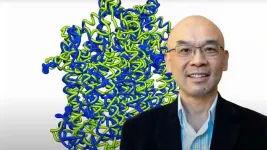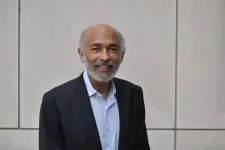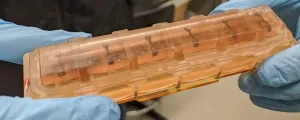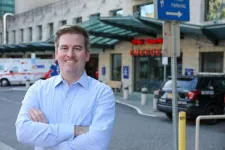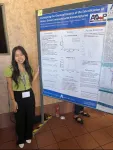(Press-News.org) Solar flares are extremely intense events that occur in the Sun’s atmosphere, lasting anywhere from a few minutes to several hours. According to the standard flare model, the energy that triggers these explosions is transported by accelerated electrons that hurtle from the magnetic reconnection region in the corona to the chromosphere. As the electrons collide with the chromospheric plasma, they deposit their energy in the plasma, which is heated and ionized as a result. They also cause intense radiation in several bands of the electromagnetic spectrum. The regions in which energy is deposited are termed solar flare “footpoints”, which normally appear in magnetically connected pairs.
A recent study set out to test the validity of the standard model by comparing results of computer simulations based on the model with observational data provided by the McMath-Pierce telescope during the solar flare SOL2014-09-24T17:50. The study focused on measuring time lags between infrared emissions from two paired chromospheric sources in the flare. An article on the study is published in the journal Monthly Notices of the Royal Astronomical Society.
“We found a significant difference between the observational data from the telescope and the behavior predicted by the model. In the observational data, the paired footpoints appeared as two very bright regions of the chromosphere. Because the incident electrons exited the same region of the corona and followed similar trajectories, the two spots should have brightened almost simultaneously in the chromosphere according to the model, but the observational data showed a delay of 0.75 seconds between them,” said Paulo José de Aguiar Simões, first author of the article and a professor affiliated with the Radio Astronomy and Astrophysics Center (CRAAM) at Mackenzie Presbyterian University’s Engineering School (EE-UPM) in São Paulo, Brazil.
A lag of 0.75 sec may seem irrelevant, but the researchers calculated that the maximum delay according to the model should be 0.42 sec considering all possible geometric configurations. The actual number was almost 80% higher. “We used a sophisticated statistical technique to infer the time lags between footpoint pairs, and estimated uncertainties for these values by the Monte Carlo method. Furthermore, the results were tested by electron transport simulations and radiative-hydrodynamic simulations. By deploying all these resources, we were able to construct different scenarios for the electrons’ time of flight between the corona and the chromosphere and the infrared radiation production time. All scenarios based on the simulations displayed far smaller time lags than the observational data,” Simões said.
One of the scenarios tested was for spiraling and magnetic trapping of electrons in the corona. “Using electron transport simulations, we explored scenarios that involved magnetic asymmetry between flare footpoints. We expected the electron chromosphere penetration time lag to be proportional to the difference in magnetic field intensity between footpoints, which would also increase the difference in the number of electrons reaching the chromosphere owing to the magnetic trapping effect. However, our analysis of X-ray observational data showed footpoint intensities to be very similar, pointing to similar amounts of electrons deposited in these regions and ruling this out as the cause of the observed emission time lags,” he said.
The radiative-hydrodynamic simulations also showed that ionization and recombination timescales in the chromosphere were too short to explain the lags. “We simulated the infrared emission timescale. We calculated electron transport to the chromosphere, electron energy deposition, and its effects on the plasma: heating; expansion; ionization and recombination of hydrogen and helium atoms; and radiation produced at the site, which has the effect of releasing excess energy. Infrared radiation is produced as a result of the increase in electron density in the chromosphere due to ionization of hydrogen, which is originally in a neutral state in the plasma. The simulations showed that ionization and infrared emissions occur almost instantly owing to penetration by the accelerated electrons, and therefore can’t explain the lag of 0.75 sec between footpoint emissions,” Simões said.
In sum, none of the processes simulated in accordance with the model proved capable of explaining the observational data. The conclusion drawn by the researchers was obvious to some extent: the standard model of solar flares needs to be reformulated, as required by the scientific method.
“The time lag observed between chromospheric sources challenges the standard model of energy transport by electron beam. The longer delay suggests other energy transport mechanisms may be involved. Mechanisms such as magnetosonic waves or conductive transport, among others, may be necessary to account for the observed delay. These additional mechanisms should be taken into consideration to achieve a full understanding of solar flares,” Simões said.
FAPESP supported the study via two projects (13/24155-3 and 22/15700-7).
About São Paulo Research Foundation (FAPESP)
The São Paulo Research Foundation (FAPESP) is a public institution with the mission of supporting scientific research in all fields of knowledge by awarding scholarships, fellowships and grants to investigators linked with higher education and research institutions in the State of São Paulo, Brazil. FAPESP is aware that the very best research can only be done by working with the best researchers internationally. Therefore, it has established partnerships with funding agencies, higher education, private companies, and research organizations in other countries known for the quality of their research and has been encouraging scientists funded by its grants to further develop their international collaboration. You can learn more about FAPESP at www.fapesp.br/en and visit FAPESP news agency at www.agencia.fapesp.br/en to keep updated with the latest scientific breakthroughs FAPESP helps achieve through its many programs, awards and research centers. You may also subscribe to FAPESP news agency at http://agencia.fapesp.br/subscribe.
END
New study raises questions about validity of standard model of solar flares
Computer simulations based on the standard model did not account for observational data obtained via telescope, showing that other factors must be taken into consideration when analyzing the process.
2024-09-23
ELSE PRESS RELEASES FROM THIS DATE:
Paving the way for new treatments
2024-09-23
A University of Missouri researcher has created a computer program that can unravel the mysteries of how proteins work together — giving scientists valuable insights to better prevent, diagnose and treat cancer and other diseases.
Jianlin “Jack” Cheng from Mizzou’s College of Engineering and his student, Nabin Giri, have developed a tool called Cryo2Struct that uses artificial intelligence (AI) to build the three-dimensional atomic structure of large protein complexes, work recently published in Nature Communications. ...
Dream discovery: Melatonin's key role in REM sleep revealed
2024-09-23
A significant breakthrough in the understanding of sleep mechanism opens new promise for treating sleep disorders and associated neuropsychiatric conditions: Scientists have pinpointed the melatonin receptor MT1 as a crucial regulator of REM (Rapid Eye Movement) sleep.
REM sleep is crucial for dreaming, memory consolidation, and emotional regulation. In the brain, the melatonin MT1 receptor affects a type of neuron that synthesizes the neurotransmitter and hormone noradrenaline, found in an ...
Research quantifying “nociception” could help improve management of surgical pain
2024-09-23
The degree to which a surgical patient’s subconscious processing of pain, or “nociception,” is properly managed by their anesthesiologist will directly affect the degree of post-operative drug side effects they’ll experience and the need for further pain management they’ll require. But pain is a subjective feeling to measure, even when patients are awake, much less when they are unconscious. In a new study, MIT and Massachusetts General Hospital (MGH) researchers describe a set of statistical models that objectively quantified nociception during surgery. Ultimately, they hope to help anesthesiologists optimize drug dose and minimize post-operative ...
How cranes navigate their complex world
2024-09-23
The researchers used tiny GPS tracking devices to follow the movements of 104 cranes in Africa, Asia, and Europe. These devices included unique solar-powered GPS leg bands developed by scientists from MPI-AB. The tracking data revealed the impressive migrations that cranes undertook. Some of the migratory routes exceeded 6,400 km of travel round trip and required crossing barriers such as the Alps or Himalaya mountain ranges, the deserts of the Arabian peninsula, or the Mediterranean Sea. In addition to the tracking study, the researchers also developed a statistical framework that revealed how the cranes’ movements relate to aspects of the ...
New origami-inspired system turns flat-pack tubes into strong building materials
2024-09-23
Engineers at RMIT University have designed an innovative tubular structural system that can be packed flat for easier transport and pop up into strong building materials.
This breakthrough is made possible by a self-locking system inspired by curved-crease origami — a technique that uses curved crease lines in paper folding.
Lead researchers, Dr Jeff (Ting-Uei) Lee and Distinguished Professor Mike (Yi Min) Xie, said bamboo, which has internal structures providing natural reinforcement, inspired the tube design.
“This self-locking system is the result of an intelligent geometric design,” said Lee from RMIT’s School of Engineering. ...
Low gravity in space travel found to weaken and disrupt normal rhythm in heart muscle cells
2024-09-23
Johns Hopkins Medicine scientists who arranged for 48 human bioengineered heart tissue samples to spend 30 days at the International Space Station report evidence that the low gravity conditions in space weakened the tissues and disrupted their normal rhythmic beats when compared to earth-bound samples from the same source.
The scientists said the heart tissues “really don’t fare well in space,” and over time, the tissues aboard the space station beat about half as strong as tissues from the same source kept on Earth.
The findings, ...
New approach to defibrillation may improve cardiac arrest outcomes
2024-09-23
Joshua Lupton, M.D., has no memory of his own cardiac arrest in 2016. He only knows that first responders resuscitated his heart with a shock from a defibrillator, ultimately leading to his complete recovery and putting him among fewer than one in 10 people nationwide who survive cardiac arrest outside of a hospital.
He attributes his survival to the rapid defibrillation he received from first responders — but not everybody is so fortunate.
Now, as lead author on a new observational study published in the journal JAMA Network Open, he and co-authors from Oregon Health & Science University ...
UTA undergraduate researcher wins state honor
2024-09-23
A student studying biological chemistry at The University of Texas at Arlington earned a state-wide award for her research on diazo compounds, the building blocks of some medications. Jenny Hoang, a senior, received the third-place award at the 2024 University of Texas System Louis Stokes Alliance for Minority Participation (LSAMP) conference held in El Paso in August.
“Honestly, I was so shocked that I won third place because I almost didn’t even apply for this program,” said Hoang, a Carrollton ...
Novel method detects biological oxidant derived from CO2 in cells
2024-09-23
High levels of carbon dioxide (CO2) in the atmosphere can alter not only the climate of our planet but also the functioning of our cells. The gas interacts with hydrogen peroxide (H2O2), which performs various functions in the human body, giving rise to a potent oxidant called peroxymonocarbonate.
"More and more evidence is emerging that peroxymonocarbonate is important in both cells’ adaptive responses via redox signaling and in cellular dysfunction. There is also epidemiological evidence that the levels of CO2 our cities are close to reaching cause a number of physiological problems. And the mechanisms underlying the toxicity of CO2 are ...
American Cancer Society experts presenting key research at 2024 ASCO Quality Care Symposium
2024-09-23
Scientists from the American Cancer Society (ACS) are presenting research studies at the 2024 Annual Meeting of the American Society of Clinical Oncology (ASCO) Quality Care Symposium (QCS) September 27-28 in San Francisco, CA. ASCO QCS offers research and education that encompasses the needs and viewpoints of multiple disciplines and various practice settings, attracting oncology professionals from around the world. This year’s program will feature studies complementing the meeting’s theme: “Driving Solutions, Implementing ...
LAST 30 PRESS RELEASES:
Breakthrough organic crystalline material repairs itself in extreme cold temperatures, unlocking new possibilities for space and deep-sea technologies
Scientists discover novel immune ‘traffic controller’ hijacked by virus
When tropical oceans were oxygen oases
Positive interactions dominate among marine microbes, six-year study reveals
Safeguarding the Winter Olympics-Paralympics against climate change
Most would recommend RSV immunizations for older and pregnant people
Donated blood has a shelf life. A new test tracks how it's aging
Stroke during pregnancy, postpartum associated with more illness, job status later
American Meteorological Society announces new executive director
People with “binge-watching addiction” are more likely to be lonely
Wild potato follows a path to domestication in the American Southwest
General climate advocacy ad campaign received more public engagement compared to more-tailored ad campaign promoting sustainable fashion
Medical LLMs may show real-world potential in identifying individuals with major depressive disorder using WhatsApp voice note recordings
Early translational study supports the role of high-dose inhaled nitric oxide as a potential antimicrobial therapy
AI can predict preemies’ path, Stanford Medicine-led study shows
A wild potato that changed the story of agriculture in the American Southwest
Cancer’s super-enhancers may set the map for DNA breaks and repair: A key clue to why tumors become aggressive and genetically unstable
Prehistoric tool made from elephant bone is the oldest discovered in Europe
Mineralized dental plaque from the Iron Age provides insight into the diet of the Scythians
Salty facts: takeaways have more salt than labels claim
When scientists build nanoscale architecture to solve textile and pharmaceutical industry challenges
Massive cloud with metallic winds discovered orbiting mystery object
Old diseases return as settlement pushes into the Amazon rainforest
Takeaways are used to reward and console – study
Velocity gradients key to explaining large-scale magnetic field structure
Bird retinas function without oxygen – solving a centuries-old biological mystery
Pregnancy- and abortion-related mortality in the US, 2018-2021
Global burden of violence against transgender and gender-diverse adults
Generative AI use and depressive symptoms among US adults
Antibiotic therapy for uncomplicated acute appendicitis
[Press-News.org] New study raises questions about validity of standard model of solar flaresComputer simulations based on the standard model did not account for observational data obtained via telescope, showing that other factors must be taken into consideration when analyzing the process.
